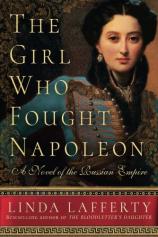The Girl Who Fought Napoleon: A Novel of the Russian Empire
Review
The Girl Who Fought Napoleon: A Novel of the Russian Empire
Linda Lafferty’s THE GIRL WHO FOUGHT NAPOLEON brings to life the tale of a valiant young woman who, in the early 19th century, disguised herself as a man to enlist in the cavalry and fight Napoleon. Nadezhda Durova is a compelling, unabashedly opinionated heroine, who, despite this book’s narrative and grammatical shortcomings, is eminently enjoyable to root for.
Nadya is literally born into the Russian army: her father and other cavalry soldiers teach her from a young age how to wield weapons and ride virtually any horse. In contrast, her mother is perennially disappointed at her detestation of anything usually “ladylike.” In despair, her mom is about to pack her off to stay with her family in the Ukraine when Nadya decides to saddle up her family’s rogue stallion --- whom, of course, only she can tame. She gallops off to join Tsar Alexander I’s fight against the French invader, Napoleon, and the rest is virtual history.
"THE GIRL WHO FOUGHT NAPOLEON emerges a winner because of its vivid depictions of war and the devastation it brings to a land."
The real Nadezhda fought and survived the bloodiest battles in the Napoleonic Wars in Russia, and Lafferty brilliantly and brutally portrays each conflict. She doesn’t glamorize life on the road as a soldier; in fact, she does anything but, showing the real-life tragedy of losing friends, going hungry and suffering crippling wounds, as well as the impact that war and conquest have on those whose lands the military occupies.
But as well drawn out as the battle scenes are, Lafferty’s version of the soldier Nadya is almost laughable. Nadya’s superiors constantly praise her for her valor and skill --- she even gets a commendation from the Tsar --- but usually her time in battle is literally spent either giving up her horse, falling off or chasing him down, or trying to find a new mount. Nadya isn’t so much a brave soldier as she is a stereotypical Gryffindor: trying to help everyone else at the expense of herself and her own comrades to the point of occasional stupidity.
The story has a constantly changing timeline --- we’ll be with Nadya in one year, then we flash to Tsar Alexander’s point of view a decade later in the next chapter. This choice is jarring and confusing. The book also suffers from being poorly edited and fact checked. It’s riddled with grammatical errors and omissions, as well as misspellings, and even some basic Googling would have given greater credibility to a novel with solid prose.
It takes only a basic knowledge of history to know that there was no “King Charles of Austria” in the early modern era (an Emperor of Austria, yes, and archdukes, to be sure, but no king for centuries). Also, the titles for a Russian Grand Duke or Duchess used here vary as often as Nadya’s mount, and Lafferty turns Queen Louise of Prussia, whom Napoleon dubbed “the only real man in Prussia,” into little more than a hyper-sexed flibbertigibbet. While Lafferty’s research of Napoleonic battles is excellent, it failed her when it came to knowledge of the individuals of the era. Finally, for some reason, a young Jules Verne makes an unnecessary appearance in Paris a decade before he was even born.
Despite its editorial flaws and sometimes hard-to-believe-in heroine, THE GIRL WHO FOUGHT NAPOLEON emerges a winner because of its vivid depictions of war and the devastation it brings to a land. Russia herself is an interesting character here, as are her many satellite states: she is an excellent heroine, one for which Nadya and Tsar Alexander fight wholeheartedly.
Reviewed by Carly Silver on September 23, 2016
The Girl Who Fought Napoleon: A Novel of the Russian Empire
- Publication Date: September 20, 2016
- Genres: Fiction, Historical Fiction
- Paperback: 442 pages
- Publisher: Lake Union Publishing
- ISBN-10: 1503937267
- ISBN-13: 9781503937260




